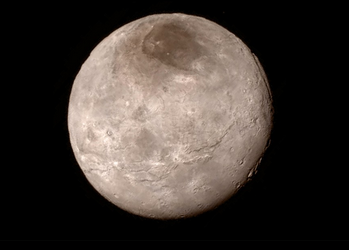

This is the New Horizons Page where we will be bringing you news and pictures from this mission.
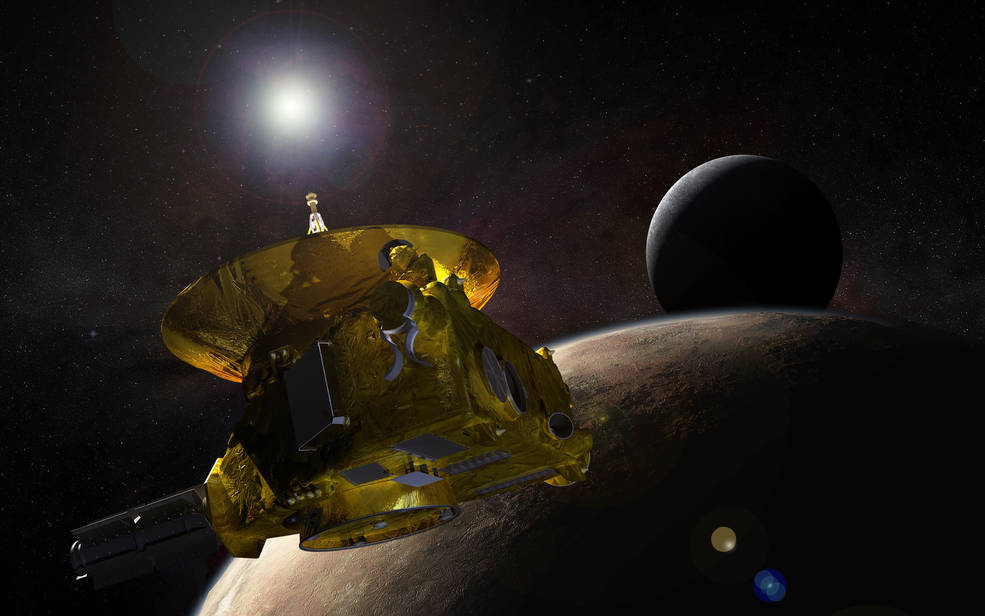
The New Horizons mission has sent a spacecraft to the outer reaches of our Solar System to look at the dwarf planet Pluto, and beyond into the Kuiper Belt.
The Kuiper Belt is the region of our Solar System beyond the orbit of the planet Neptune about 30 Astronomical Units (AU) from the Sun and out to about 50 AU. This region contains the minor planet Pluto and it's moons Charon, Hydra, Nix and Styx along with many comets, asteroids and many other small objects mostly made of ice.
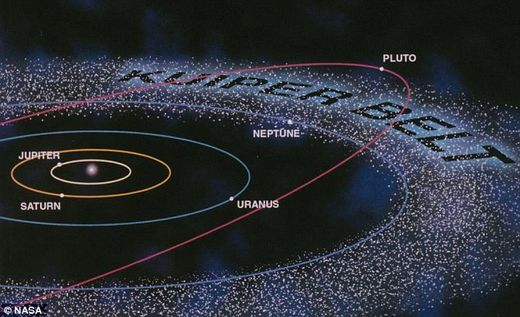
An AU or Astronomical Unit is equal to the distance between the Sun and the Earth about 93,000,000 miles or 150,000,000 km.

The New Horizons spacecraft was launched from Cape Canaveral Air Force Station, space launch complex 41 Florida, at 2:00.00 pm EST on 19th January 2006 almost ten years ago. On a long journey to the almost totally unexplored outer regions of our Solar System.
This launch was the third attempt after two previous attempts that week. The first was called off because of high winds at the launch site and the second due to a power failure at the Johns Hopkins University, Applied Physics Laboratory in Laurel, Md. who operate the New Horizons mission.
Web Site : Johns Hopkins University, Applied Physics Laboratory New Horizons
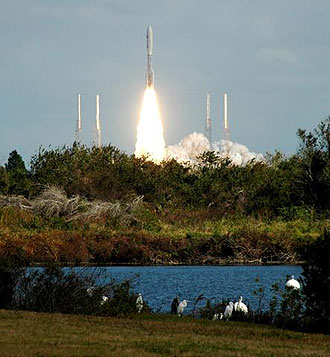
This journey was shortened by a Gravity Assist (sling shot) manoeuvre around the planet Jupiter in February 2007.
This type of manoeuvre takes the spacecraft very close to a planet or other large object in space and uses the gravity of that object to accelerate the spacecraft and throw it on its way, much like a sling shot does to a stone.
The New Horizons team did not waste the opportunity to study Jupiter and its moon's while they were passing.
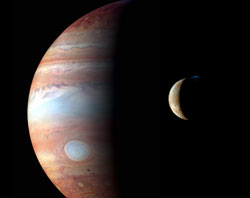
During the New Horizons spacecraft's flyby of Jupiter in February 2007 it took this picture of Jupiter in infrared color composite using the spacecraft's near-infrared imaging spectrometer.
The approximately true-colour composite picture of Io was taken on 1st March 2007. The image shows a 330 km high volcanic eruption of the volcano Tvashtar on Io's night side.
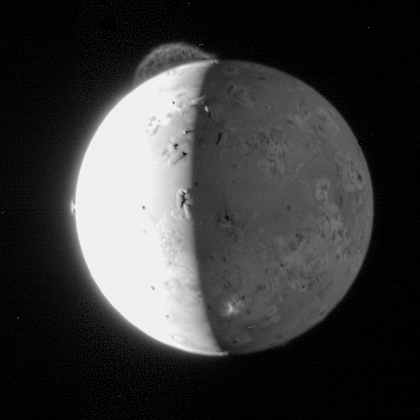
After the New Horizons gravity assist manoeuvre (sling shot) around Jupiter it was time for a long sleep during the long trip out to Pluto.
This hibernation phase of its journey will reduce the cost of its operation, free up deep space network tracking systems for other missions and reduce wear on many of the spacecraft's systems.
The spacecraft was put into a stabilising spin at 5 rpm with the antenna pointing towards Earth. Then all unused components, guidance and control systems were powered down.
The flight computer was left running and monitored system health, sending a weekly beacon message back to Earth.
Once a year New Horizons was woken up to do course corrections, system checks and instrument calibration.
New Horizons was the first mission to make operational use of hibernation and the weekly beacon message.
The spacecraft was the fastest ever to leave Earth at almost 100 times that of a jet-liner. Also no spacecraft has ever travelled as far to reach its primary target.
New Horizons reached the Moon's orbit is just 9 hours where the Apollo Mission in the 1960's took 3 days.
It took just 13 months to reach Jupiter, Cassini and Galileo took four and six years. But still it would take nearly 10 years to reach Pluto!
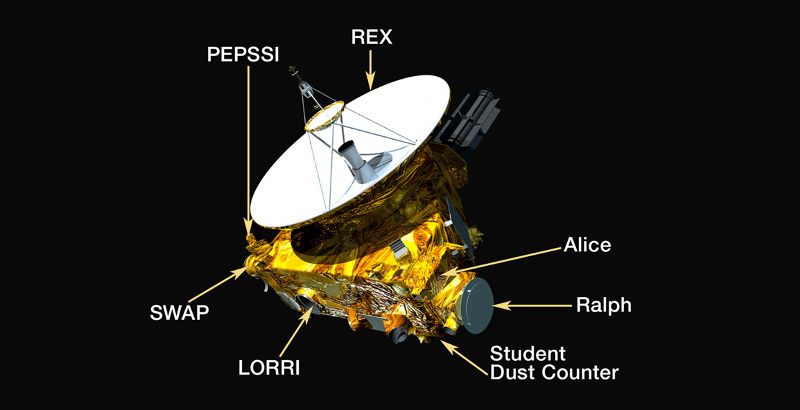
On 6th December 2014 New Horizons woke up from its long sleep. After nearly nine years flight and almost three billion miles the spacecraft was at last in the final phase of its journey to Pluto.
No spacecraft had ever travelled so far to reach its primary target. New Horizons was now only 162 million miles from Pluto. The radio signal sent to Earth from New Horizons to confirm it had woken up took four hours and twenty six minutes to reach NASA's Deep Space Network Station in Canberra Australia.
The spacecraft had spent 1,873 days hibernating in eighteen separate periods, from as little as 36 days to as much as 202 days.
The engineers spent several weeks checking all the instruments and systems were working. Then on January 15th 2015 New Horizons began observing the Pluto System.
In mid May the pictures from New Horizons cameras were even better than the best the huge Hubble Telescope could produce.
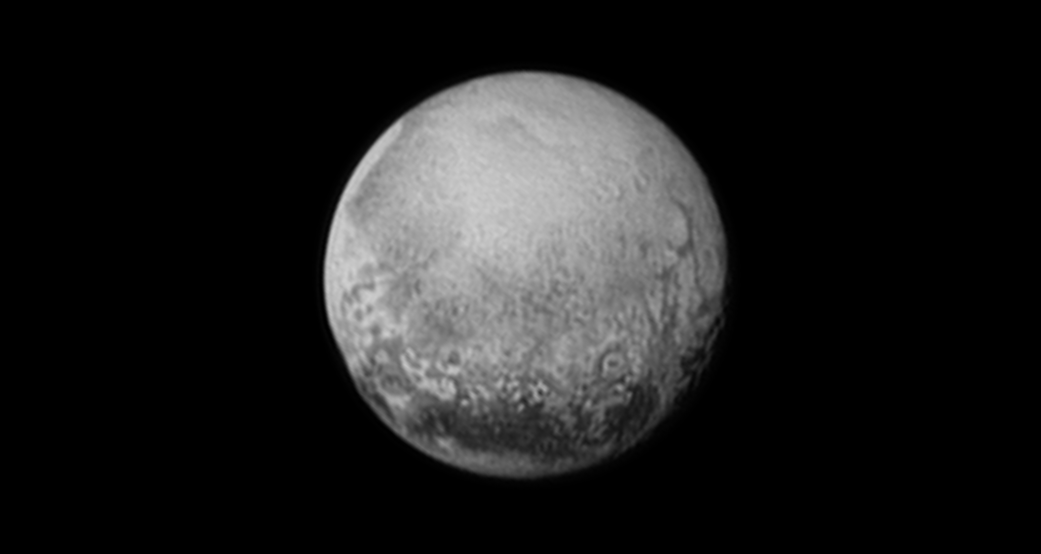
As the New Horizons spacecraft approaches Pluto it will use 'Optical Navigation' to adjust its course so that it passes through a 300km circle to ensure it can carry out all of its objectives at Pluto.
Optical Navigation is no more than navigating by eye, or in the case of New Horizons by the cameras on board taking pictures and sending them back to Earth.
The thrusters used to change New Horizons course only produce 4.4 newtons (about 1 lb) of thrust compared to the total weight of the spacecraft at about 1,000 lb. Its a good thing that only small corrections need to be made.
New Horizons observed the Pluto System for 5 months as it approached. At about 60 million miles, just 3 months away, the on-board cameras started to map Pluto and its neighbour Charon and the small moons Nix and Hydra.
During the last four Pluto days (26 Earth days) the cameras will map Pluto and its moons every half Pluto day. This will enable the scientists to detect weather on Pluto such as fresh snow fall.
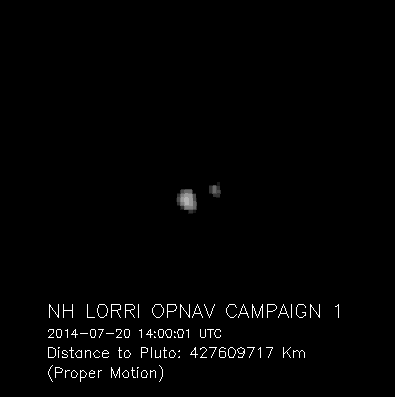
You may be wondering why there are not loads of pictures coming from New Horizons ? We are only getting one or two a day. This is because the New Horizons spacecraft is over three billion miles from Earth.
Today we are used to being able to stream video live over the internet, but some people that live more than a few miles from their telephone exchange still live in the dark ages with respect of internet speeds, they are unable to achieve speeds much faster than the 56 Kbps modems of 20 years ago.
We are not talking of a few miles here, New Horizons is over 3 billion miles away and to make matters worse the antenna on the spacecraft has an output of only 12 watts. Imagine a 12 watt bulb at 3 billion miles.
All this results in a downlink speed to Earth of between 1 - 2 Kbps (thousand bits per second) just remember when it took several minutes to load a web page on your old dial up 56 Kbps modem, this is only 1 or 2 Kbps. Today's internet high speed internet runs at over 100 Million bits per second!
It takes over four hours just for the signal to travel at the speed of light, from New Horizons to Earth. But all this is not the whole story...
When the 12 watt signal reaches Earth it is picked up by the huge antenna dishes that are part of NASA's Deep Space Network. The received data is then sent to New Horizons mission control at APL and there it is decompressed and cleaned up and stored in daily archive files. These files are sent to the Science Operations Centre where it is sorted and used to produce useful science data.
It will take New Horizons 16 Months to send all of its data back to Earth. We will be updating this page for some time to come !!!
Pluto from 476,000 miles on 13th July 2015.
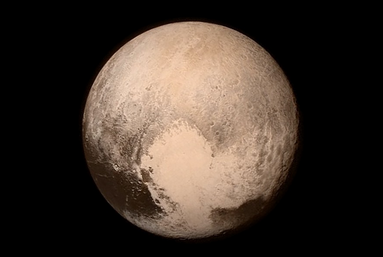
Close up of a large crater less plain in Pluto's heart shaped feature, this plain looks like it is most likely less than 100 million years old and may still be undergoing changes caused by Pluto's geological processes.
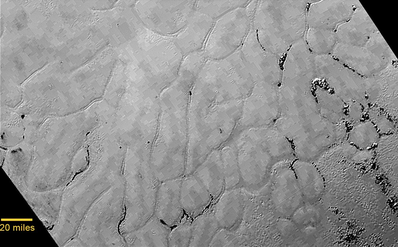
Close up of a mountain range near Pluto's equator with mountains as high as 11,000 feet or 3,500 meters.
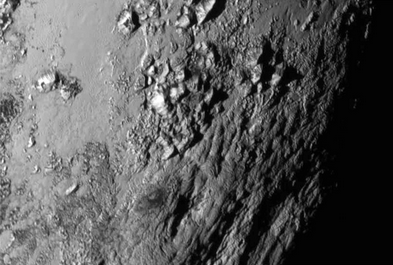
Charon, Pluto's largest moon on 13th July 2015, from only 289,000 miles. Very few craters are visible on Charon, this suggests the surface is not very old and has probably been reshaped by geological processes.
